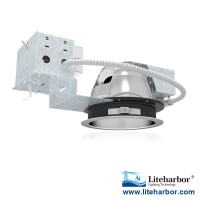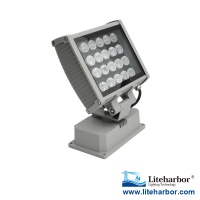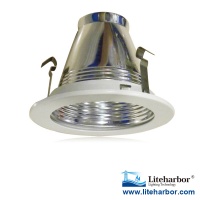Track Lighting Standards
track lighting is a method of lighting where light fixtures are attached anywhere on a continuous track device which contains electrical conductors.[1] This is as opposed to the routing of electrical wiring to individual light positions. Tracks can be mounted to ceilings or walls, lengthwise down beams, or crosswise across rafters or joists. They can also be hung with rods from especially high places like vaulted ceilings.
Three track lighting standards
It’s important to understand that, over the years, track lighting has settled into three major standards: ‘H type’, ‘J type’ and ‘L type’. When buying additional fixtures or components for an existing track lighting system, it is essential to buy components designed for the same standard.
If you are designing a new system, it is sufficient to understand that you should use ‘H type’ track. The ‘H type’ standard has certain design advantages over the other standards and thus makes up the majority of new systems installed today.
track lighting limitations
For all its merits, track lighting does have limitations. One limitation is that, typically, every fixture on a given piece of track is on a single circuit and thus must be controlled together. Thus, it is impossible to dim one or more fixtures independently of the others. This limitation may be overcome somewhat by using dual circuit track.
Dual circuit track allows fixtures to be isolated into two groups and controlled independently. Often, this is used to dim pendants separately from track heads attached to the same run of track. It should be noted that the point of power (the junction box to which the system will be installed) must be wired appropriately to allow independent control of two groups of fixtures.
Installing track systems
track lighting systems are not extremely difficult to install. For those comfortable working with electricity, the systems may typically be installed in less than an hour. For those not comfortable with such projects, any experienced electrician should be able to install a track system of any standard quickly and easily. track lighting offers an extremely versatile and, recently, stylish way to add accent and task lighting to almost any space.
What are the differences between each track systems?
H-Type Track System (HT)
The HT system is known as 3-wire single circuit systems and is the most popular track system on the market today. HT compatible system is available at most home improvement centers. If you look at the track, then there should be 2 strip of wire on one side and 1 strip of wire on the other side. If you look at the back of the fixture junction plate, then there should be 2 clip terminals on one side and 1 clip terminal on the other side. HT is the most affordable system due to many vendors selling HT compatible system, thus the price is favorable for consumer. We recommend using the HT system for new installation.
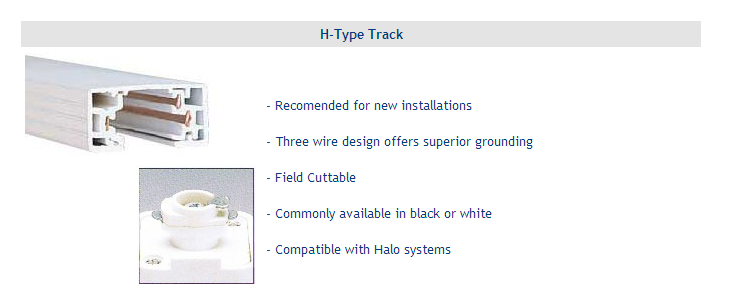
J-Type Track System (JT)
The JT system is known as 2 wire-wide single circuit system. If you look at the track, then there should be 1 strip of wire on one side and 1 strip of wire on the other side. If you look at the back of the fixture junction plate, then there should be 1 clip terminals on one side and 1 clip terminal on the other side. If you measure the outside tip of the clip from one end to the other outside tip (maximum distance between the clips, ). It should be just shy of 1", it should be around 15/16". then you have a JT 2-wire-wide system.
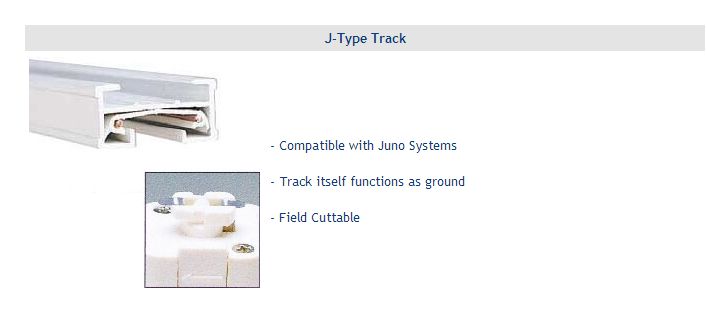
L-Type Track System (LT)
The LT system is known as 2-wire-narrow single circuit system. Our LT system is compatible with Lightolier Radius series and may not be compatible with any other series. If you look at the track, then there should be 1 strip of wire on one side and 1 strip of wire on the other side. If you look at the back of the fixture junction plate, then there should be 1 clip terminals on one side and 1 clip terminal on the other side. If you measure the outside tip of the clip from one end to the other outside tip (maximum distance between the clips, ). It should be just more of 12/16", it should be around 13/16". If so, then you have a LT 2-wire-narrow system.
Please see the following images for measuring instruction:
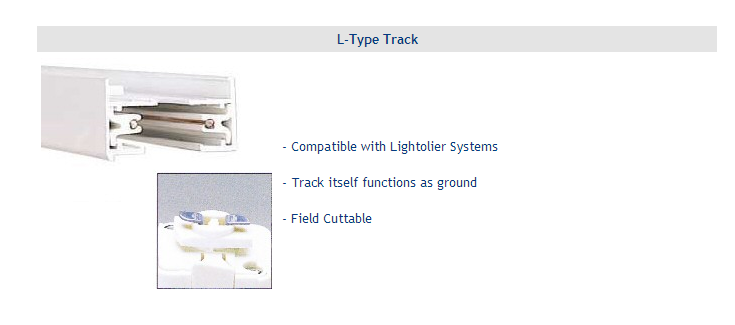
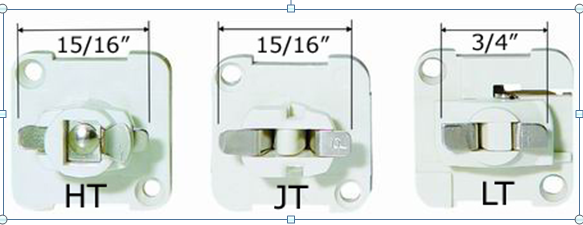
Which system to use for new installation?
We recommend the HT system for new installation. The HT system is 3-wire single circuit systems and is compatible with track systems available at most home improvement centers.
How UL Standards Say
Standard for track lighting Systems
1.1 These requirements cover track lighting systems intended for permanent connection to sources of supply in commercial or residential ordinary locations in accordance with the National Electrical Code, NFPA 70. The track lighting systems covered by this standard are rated:
a) 300 volts or less;
b) 150 volts or less to ground; and
c) 50 amperes or less.
1.2 Lighting track is intended to be permanently installed and permanently connected to a branch circuit not exceeding 277 volts, nominal to ground, and 50 amperes.
1.3 These requirements cover:
a) Track networks consisting of track and connectors;
b) Mono-, duo-, and multi-point canopies;
c) Incandescent, fluorescent, and high intensity discharge (HID) luminaire assemblies intended to be electrically connected to and physically supported by the track in track networks and canopies;
d) Mounting means for the track; and
e) Accessories.
1.4 These requirements do not cover:
a) Busways intended for lighting, receptacles, or other general-purpose adaptors covered by the Standard for Busways, UL 857, and intended for use in accordance with Article 364 of the National Electrical Code, NFPA 70; or
b) track lighting systems for marine use aboard a ship or boat.
1.5 track lighting systems are not intended for use:
a) In wet or damp locations;
b) In installations where the track is concealed;
c) In hazardous locations;
d) Where subject to physical damage;
e) Where the track is extended through walls or partitions of building structures;
f) Where subject to corrosive vapors; or
g) In storage battery rooms.
1.6 A track lighting luminaire assembly that uses a tungsten-halogen lamp, fluorescent lamp, or high-intensity-discharge lamp shall also comply with the applicable requirements from the Standard for Luminaires, UL 1598.
1.7 Light emitting diode (LED) components and subassemblies integral to lighting track or a luminaire assembly covered by this standard shall comply with the applicable requirements of the Standard for Light Emitting Diode (LED) Equipment for Use in Lighting Products, UL 8750.

 RESOURCE
RESOURCE




